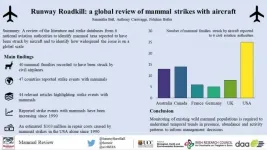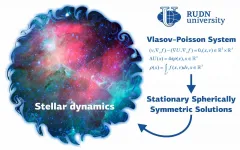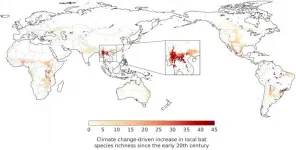(Press-News.org) - World's wildlife, from giraffes to voles, kangaroos to coyotes being hit by aircraft.
- Study identifies incidences at airports in 47 countries across the globe.
- 'Runway Roadkill' increasing by up to 68% annually and has caused damage that has cost in excess of $103 million in the United States alone over a 30 year period.
- It is hoped study could pave way for international efforts to protect wildlife and reduce costly aircraft damage.
From giraffes to the world's smallest mammals, the world's wildlife is being increasingly struck by aircraft, a global study finds.
Airports from Sydney to London and the USA to Germany were examined by researchers who found that incidences of mammal strikes with aircraft - so-called 'runway roadkill' - are increasing significantly year-on-year, are costing aviation authorities millions per annum, but are under-reported internationally.
The international study led by University College Cork (UCC) researcher Samantha Ball, found that 'runway roadkill' has been increasing by up to 68% annually and have caused damage that has cost in excess of $103 million in the United States alone over a 30 year period.
The global review of mammal strikes with aircraft, is funded by the Irish Research Council and the Dublin Airport Authority and is published in Mammal Review.
It is hoped the findings of the study may aid aviation authorities worldwide to increase mitigation measures to protect wildlife and prevent costly damage.
Ms Ball of UCC's School of Biological, Earth & Environmental Sciences said mammals are incredibly diverse and those involved in strike events are no exception.
"As we identified 47 countries which have reported strikes with mammals, the species involved ranged from some of the world's smallest mammals, such as voles, all the way up to the mighty giraffe and included mammals of all sizes in between. As strike events can affect everything from passenger safety, airline economics and local conservation, understanding the species composition and ecology of the local fauna at an airfield is paramount for effective strike mitigation," she said.
However, most aircraft strikes involve birds, meaning there has been comparatively little research to date on collisions with mammals.
The airport environment can provide productive habitat for wildlife due to expanses of semi-natural grasslands, creating favourable ecological habitats, often in heavily urbanised areas.
Airport operators have a legal obligation to reduce wildlife hazard at airfields. It is therefore important for airports to understand the relative risk associated with each species, in order to prioritise and implement effective Wildlife Hazard Management Plans (WHMP).
By analysing published information and mammal strike data from national aviation authorities in Australia, Canada, France, Germany, the United Kingdom, and the United States, researchers found that bats accounted for the greatest proportion of strikes in Australia; rabbits and dog-like carnivores in Canada, Germany, and the United Kingdom; and bats and deer in the United States. Average mammal strikes per year ranged from 1.2 to 38.7 across the countries analysed, for every million aircraft movements.
Researchers identified:
- Reports of around 10 strikes a year with kangaroos
- Around 40 strikes a year with coyotes
- Around 60 strikes with skunks.
- Around 100 strikes a year with fruit bats in Australia
- Over 100 strikes annually in recent years with leporids (rabbits and hares) in only three countries in Europe (France, Germany, UK).
They also found that:
- More mammals were struck during the landing phase of an aircraft's rotation than any other phase.
- Dusk was identified as having the highest strike rate per hour for Australia and the USA and night conferred the greatest risk in Canada and Germany.
- In the USA, it is estimated that mammal strikes are five times more likely to cause damage to aircraft than bird strikes.
- Under-reporting of strikes is recognised on both an international and national level: estimates suggest that only 5-47% of wildlife strikes are reported to aviation authorities, and the reporting of strike events remains voluntary in many countries.
The researchers argue that the ecological and behavioural traits of mammal populations in proximity to and inhabiting airports need to be understood and integrated into WHMPs if effective management policies are to be developed and implemented.
"Therefore, mitigation measures developed in the USA for the specific fauna of North America may not be effective for high-risk species in other parts of the world. As air travel is a global industry, increased research efforts targeted at high risk mammal families outside the USA would benefit not only the national aviation authorities responsible for the research, but also international authorities and airline operators. A more thorough understanding of the ecology of mammal groups inhabiting and using airfields is required to maximise the efficacy of any mitigation measures," their paper argues.
INFORMATION:
LEBANON, NH - Dartmouth's and Dartmouth-Hitchcock's Norris Cotton Cancer Center (NCCC) is the first cancer center in the world to install BeamSite Cherenkov imaging cameras in its radiotherapy treatment rooms. The camera system, invented, validated and commercialized by entrepreneurs from NCCC and Dartmouth spinoff biomed tech company, DoseOptics, LLC, captures imaging and real-time video of the beam directly on the patient, allowing the radiation oncology team to visualize treatment delivery.
Cherenkov imaging makes radiation treatment a visual process. The Cherenkov effect occurs when photon or electron radiation beams interact with tissue, such as skin, producing a small light ...
University of Texas at Arlington researchers have developed a technique that programs 2D materials to transform into complex 3D shapes.
The goal of the work is to create synthetic materials that can mimic how living organisms expand and contract soft tissues and thus achieve complex 3D movements and functions. Programming thin sheets, or 2D materials, to morph into 3D shapes can enable new technologies for soft robotics, deployable systems, and biomimetic manufacturing, which produces synthetic products that mimic biological processes.
Kyungsuk Yum, an associate professor in the Materials ...
URBANA, Ill. ¬- Mealtimes are a central aspect of family life, affecting the health and wellbeing of both children and adults. Although the benefits of healthy mealtimes are straightforward, helping all families realize those benefits is quite complicated, new research from University of Illinois shows.
The study highlights ways in which some solutions - such as an exclusive focus on improving food access or on improving mealtime preparation and organization skills - may be less effective if done in isolation, says Allen Barton, assistant professor in the Department of Human Development and Family Studies at ...
Researchers from Kumamoto University (Japan) have clarified the mechanism by which blood and lymph vessels remain segregated from one another after development. The characteristics and structures of these two vessel types are very similar, and how they maintain separation has remained unexplained for many years. In this study, researchers found that the molecule Folliculin (FLCN) in vascular endothelial cells acts as a gatekeeper to maintain that separation.
Blood and lymphatic vessels form independent networks until the final confluence at the left and right venous angles in the neck. Blood vessels act as a pipeline that ...
We've all felt stressed at some point, whether in our personal or professional lives or in response to exceptional circumstances like the COVID-19 pandemic. But until now there has been no way to quantify stress levels in an objective manner.
That could soon change thanks to a small wearable sensor developed by engineers at EPFL's Nanoelectronic Devices Laboratory (Nanolab) and Xsensio. The device can be placed directly on a patient's skin and can continually measure the concentration of cortisol, the main stress biomarker, in the patient's sweat.
Cortisol: A double-edged sword
Cortisol is a steroid hormone ...
The group led by Dr. Enrique J. Calderón - "Clinical Epidemiology and Vascular Risk" at the Institute of Biomedicine of Seville - IBiS/University Hospitals Virgen del Rocío and Macarena/CSIC/University of Seville, also a member of CIBERESP, participated in a project with researchers from CIBER-BBN, in which they developed systems to detect Pneumocystis jirovecii, an atypical fungus responsible for very severe pneumonia in immunosuppressed patients. The results have been published in the journals Nanomaterials and Journal of Fungi, and are the fruit of collaboration with the CIBER-BBN groups led by Dr. Laura Lechuga, ...
The spinal column consists of 24 vertebrae that provide axial support to the torso and protection to the spinal cord that runs through its central cavity. The vertebrae are connected by means of intervertebral discs. These discs are highly hydrated, flexible and highly mechanically resistant. They allow the column its flexibility and act as shock absorbers during daily activities such as walking, running and in impact situations, such as jumping.
These unique features are made possible by the discs' tissue composition and structure. At its centre, there is a gel-like ...
At the time of writing, coronavirus disease 2019 (COVID-19) is seriously threatening human lives and health throughout the world. Before effective vaccines and specific drugs are developed, non-pharmacological interventions and numerical model predictions are essential. To this end, a group led by Professor Jianping Huang from Lanzhou University, China, developed the Global Prediction System of the COVID-19 Pandemic (GPCP).
Jianping Huang is a Professor in the College of Atmospheric Sciences and a Director of the Collaborative Innovation Center for Western Ecological Safety, Lanzhou University, China. He has for a long time been dedicated to studying ...
The Vlasov-Poisson equations describe many important physical phenomena such as the distribution of gravitating particles in the interstellar space, high-temperature plasma kinetics, and the Landau damping effect. A joint team of scientists from the Mathematical Institute of RUDN University and the Mathematical Institute of the University of Munich suggested a new method to obtain stationary solutions for a system of Vlasov-Poisson equations in a three-dimensional case. The obtained solutions describe the phenomena of stellar dynamics. The results of the study were published in the ...
Global greenhouse gas emissions over the last century have made southern China a hotspot for bat-borne coronaviruses, by driving growth of forest habitat favoured by bats.
A new study published today in the journal Science of the Total Environment provides the first evidence of a mechanism by which climate change could have played a direct role in the emergence of SARS-CoV-2, the virus that caused the COVID-19 pandemic.
The study has revealed large-scale changes in the type of vegetation in the southern Chinese Yunnan province, and adjacent regions in Myanmar and Laos, over the last century. Climatic changes ...






